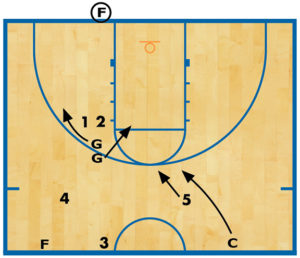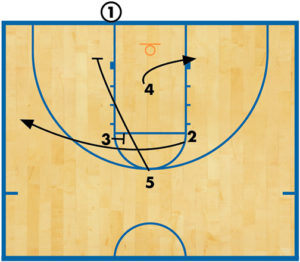Unconventional transition offense keeps D off balance
We’ve successfully developed and implemented a system of transition offense that’s unconventional and tough for opponents to defend.
We decided to start using this system to utilize what little speed our team possessed. Our two guards were quick, but our 3, 4, and 5 positions were not. If we let our guards fill the outlet spots, it clogged the lanes as the guards would ultimately end up dribbling into the back of our forwards and post players.
Naming system
In this new system, we decided to call our 3, 4, and 5 players “outlets,” and referred to the guards as “jets.” Jet players are never outlets.
After we control a defensive rebound, both jets release downcourt on opposite sidelines. The player who secures the rebound pivots out and looks for an open jet. The other two outlets fill the spots along the sideline. If a jet secures the rebound, they quickly look for the other jet. This action gives our team a chance to create a quick open layup. This never happened when our guards were outlets.
This system works well enough that we now use it as our press-breaker. Instead of a rebounder, we have an inbounder. All other positions operate the same. Often, this transition beats a press down the floor before it can set up. There are a few other advantages to utilizing this system.
- It takes a lot of pressure off the guards and rewards them for running hard down the floor.
- It forces 3, 4, and 5 to become part of the transition game. Before this system, these players tended to trot up the floor with their backs to the ball. They depended too much on the guards to initiate the action.
- It gives guards the ball with a “fresh” dribble and puts them in position to set up the offense.
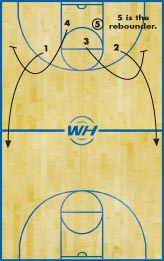
DIAGRAM 1: On a defensive rebound, the jets release down the sideline and the outlets fill outlet spots. The rebounder must look long downcourt and threaten the long pass.

DIAGRAM 2: If the long pass isn’t available, the rebounder outlets the ball and runs the opposite sideline. The outlet that does not receive the ball flashes to an opening in the middle lanes.
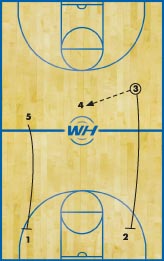
DIAGRAM 3: The outlet checks for the long pass and passes to the middle lane. The outlets without the ball set screens for both jets.
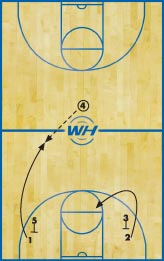
DIAGRAM 4: The jets use the screens to get open. They can curl and backcut off the screen. Most times, they should break straight toward the ball. After receiving the ball, the jet becomes the point guard and can set up the offense with a “fresh” dribble. Remember, you can do this same action after a made basket with the rebounder becoming the inbounder.
Using our old system, good spacing during transition was virtually unattainable and something that desperately needed to be changed. We had a 30-6 record after we began using this transition all of the time — during made baskets, rebounds off missed shots, against full-court pressure, free throws, etc.

